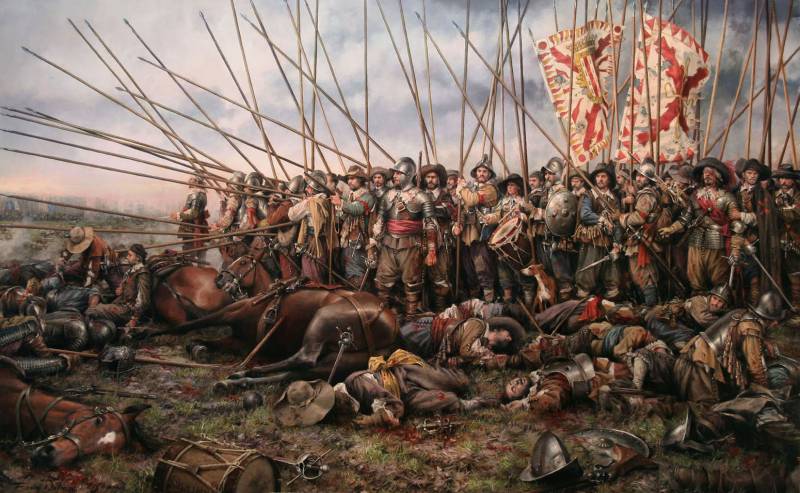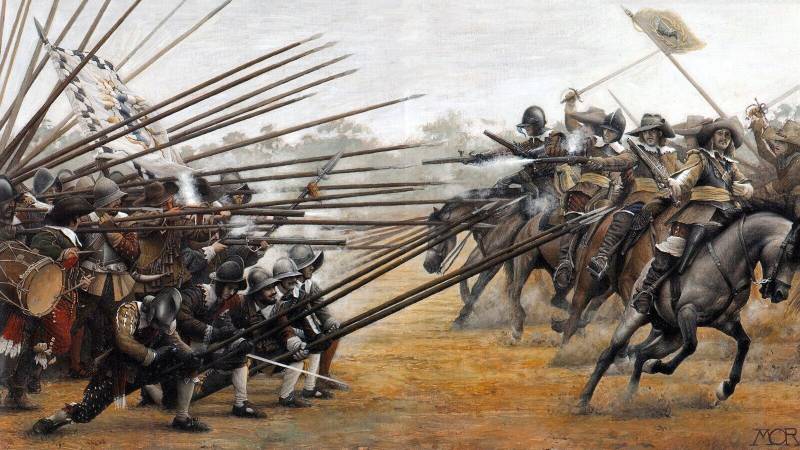Pick: the story of the long-liver from the world of cold weapons
For the first time the peak appeared in service at the beginning of the XV century. Roughly speaking, a long spear was known in ancient times, and some historians even point to finds made before the advent of Homo Sapiens. But among the peers of Pike there are several important features:
First, the peak was much longer and heavier than conventional combat copies. It provided only a two-handed grip, during which its shaft was clamped under the arm - only this way it was possible to hold the tip at the right angle. Of course, it was very difficult to make frequent injections and, moreover, to throw most of the peak variants at the enemy because of their mass and shape - perhaps for the purpose of the element of surprise.
Secondly, the tip of the peaks is designed for the breakdown of armor, and therefore has a narrow faceted shape. Unlike other spears, especially eastern ones, they could only be given piercing blows. However, it would be more honest to say that in order to “strike” blows with something as long as the Mauritanian peak, you need to possess impressive physical strength. Usually, they simply put it in the direction of the enemy and tried to podgadat the moment so that the rider or his horse independently flew to the tip.
Macedonian phalanx of pikemen
Why, then, spears, and peaks in particular, had such popularity and efficiency? Mass culture loves spears much less than swords and axes, but in a real open battle the spear was almost irreplaceable.
To begin with, the spear is at least a pair (and sometimes six) of a pole flag between you and the enemy, with a sharp tip on his side. Such an advantage in battle can not provide any other weapon: a dense formation, lined up with spears, becomes a very serious obstacle to the way of both foot and equestrian troops. It is very easy to make a spear - all you need to do is to find and trim a suitable pole, adding a tip and a counterweight. Even a sharp stick, burned on fire, could become a dangerous weapon in the hands of a skilled fighter, what can we say about a full-fledged weapon with a tip of sharp steel, equipped with a crosspiece. It is not so easy to cut the spear shaft - as a rule, the blow will be tangential, which will reduce its strength, besides, many spears are further forged with iron to increase strength.
There are three main types of peak:
Anticular, or the “Moorish” peak was a record holder in size, its length ranged from 4,5 to 7 meters. Crowned with a long (up to 50 cm) tetrahedral tip, it was a formidable weapon that could, with a favorable set of circumstances, string a knight on a point like a shish kebab.
European The peak is the average variant of the peak, which lived to the First World War. Universal weapon of infantry and cavalry, popular due to the ratio of size and efficiency. Despite the fact that its length was usually in the 3,3 area of meters, the tip of such a peak did not usually exceed 12, see. Pickers lined up in several lines, trying to increase their efficiency, which from the side of the formation resembled a porcupine fixed with long needles.
Boarding peak, as you might guess, was used by sailors during boarding, when the ships are engaged onboard. It was shorter than the land analogue (1 − 1,8 m), which is not surprising - on a shaky deck, in the crush of a battle, an excessively long shaft was only a hindrance. She was pricked, she was thrown at opponents, and boarding hooks were pushed into the water. Due to the distance, which guaranteed the peak, it was often much more effective than the usual knives and sabers.
The shortening of the peaks began to occur with the introduction of mobile artillery into service, and its decline came at the same time when the cavalry ceased to participate in the battles - right up to 1920 − 30, when it almost disappeared from everyday life. Instead of rush began to use bayonets, which were mounted on the muskets - if necessary, they could quite effectively fight back in melee.



Information